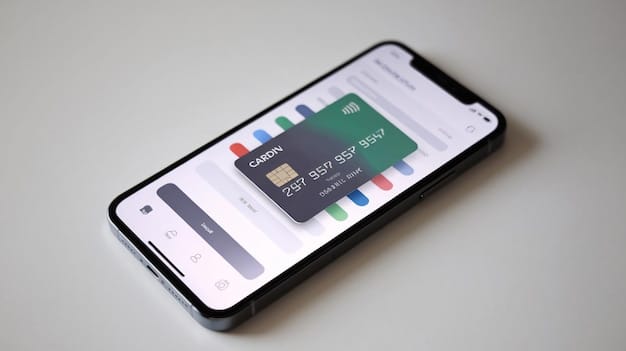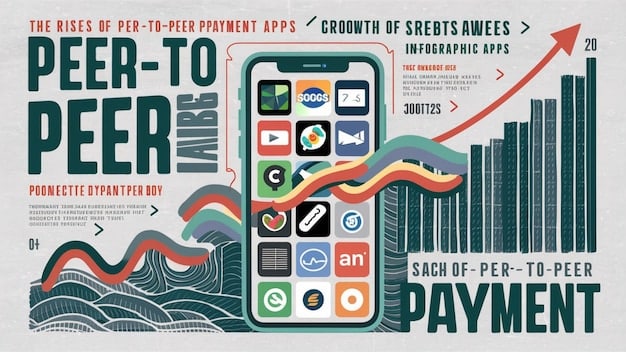Mobile Wallets: Boost US E-commerce Conversions with Apple Pay & Google Pay

Mobile wallets like Apple Pay and Google Pay can increase e-commerce conversions by 7% in the US market, offering a seamless and secure payment experience for customers. Embracing these payment options is crucial for businesses aiming to enhance customer satisfaction and drive sales.
Are you looking to boost your e-commerce conversion rates in the US market? Mobile wallets: Accepting Apple Pay and Google Pay to increase conversions by 7% for US e-commerce is becoming increasingly important. Integrating these payment options can provide a significant competitive edge, offering a streamlined and secure checkout process for your customers.
By embracing the convenience and security of Apple Pay and Google Pay, you can tap into a growing segment of mobile-savvy shoppers. Let’s explore how these payment methods can transform your e-commerce business and drive higher sales.
Understanding the Rise of Mobile Wallets in US E-commerce
Mobile wallets have revolutionized the way consumers shop online, especially in the United States. Offering convenience, security, and speed, these digital payment methods are rapidly becoming the preferred choice for many e-commerce shoppers. Understanding this shift is crucial for businesses looking to stay competitive.
What are Mobile Wallets?
Mobile wallets are digital apps that store payment information, allowing users to make transactions with their smartphones or smart devices. Platforms like Apple Pay and Google Pay use Near Field Communication (NFC) or QR code technology to enable contactless payments, providing a seamless experience for users.
The Growing Popularity in the US Market
The adoption of mobile wallets has been steadily increasing in the US, driven by factors such as the increasing use of smartphones, growing consumer trust in digital payments, and the ease of use they offer. According to recent studies, a significant percentage of US consumers now prefer using mobile wallets for their online and in-store purchases.
- Convenience: Mobile wallets eliminate the need to carry physical cards, making payments quicker and easier.
- Security: These platforms use advanced encryption and tokenization to protect sensitive payment information.
- Speed: Contactless payments are generally faster than traditional card transactions, reducing checkout times.
- Rewards: Many mobile wallets offer loyalty programs and rewards, incentivizing users to make payments through their platforms.

In conclusion, the rise of mobile wallets in the US is undeniable, and businesses that fail to embrace this trend risk falling behind. By understanding the benefits and popularity of these payment methods, e-commerce businesses can make informed decisions about integrating them into their checkout processes.
The Impact of Apple Pay and Google Pay on E-commerce Conversions
Integrating Apple Pay and Google Pay into your e-commerce platform can have a significant impact on your conversion rates. These mobile payment solutions offer a superior user experience, leading to increased customer satisfaction and higher sales. Let’s delve into the specifics of how these platforms can benefit your business. Mobile Wallets: Accepting Apple Pay and Google Pay to increase conversions by 7% for US e-commerce requires a strategic approach.
Streamlined Checkout Process
One of the primary advantages of Apple Pay and Google Pay is their streamlined checkout process. Customers can complete transactions in just a few taps, without having to manually enter their card details or shipping addresses. This simplified experience reduces friction and minimizes the chances of cart abandonment.
Enhanced Security Measures
Security is a top concern for online shoppers, and mobile wallets address this concern by using advanced security measures. Apple Pay and Google Pay utilize tokenization, which replaces sensitive card details with a unique digital identifier, protecting customer data from potential breaches. This added layer of security builds trust and encourages customers to complete their purchases.
The integration of Apple Pay and Google Pay can drive a 7% increase in e-commerce conversions through:
- Reduced Checkout Time: Eliminating manual data entry speeds up the payment process.
- Increased Trust: Enhanced security measures reassure customers and boost confidence.
- Improved User Experience: Seamless transactions lead to higher satisfaction and repeat purchases.
Real-World Examples
Numerous e-commerce businesses have reported significant improvements in their conversion rates after implementing Apple Pay and Google Pay. These success stories highlight the tangible benefits of embracing mobile wallets. For instance, retailers have seen a noticeable increase in sales among mobile users who prefer the convenience and security of these payment methods.
In conclusion, the impact of Apple Pay and Google Pay on e-commerce conversions is substantial. By providing a faster, more secure, and user-friendly payment experience, these mobile wallets can help businesses increase their sales and improve customer loyalty.
Optimizing Your E-commerce Site for Mobile Wallet Integration
Successfully integrating mobile wallets like Apple Pay and Google Pay into your e-commerce site requires careful planning and execution. From ensuring compatibility to optimizing the user interface, several key steps can help you maximize the benefits of these payment solutions. Mobile Wallets: Accepting Apple Pay and Google Pay to increase conversions by 7% for US e-commerce needs a well-optimized platform. Ensure that your website is fully optimized.
Ensuring Compatibility
The first step is to ensure that your e-commerce platform is compatible with Apple Pay and Google Pay. Most modern platforms offer plugins or extensions that facilitate seamless integration. However, it’s essential to verify compatibility and test the integration thoroughly before going live.
Optimizing the User Interface
The user interface plays a crucial role in the success of mobile wallet integration. Make sure that the Apple Pay and Google Pay buttons are prominently displayed on your checkout page and product pages. Use clear and concise messaging to guide users through the payment process.
- Mobile-Friendly Design: Ensure your e-commerce site is fully responsive and optimized for mobile devices.
- Clear Call-to-Actions: Use clear and concise messaging to guide users through the payment process.
- Simplified Checkout: Reduce the number of steps required to complete a purchase.

Testing and Monitoring
Once you have integrated Apple Pay and Google Pay, it’s essential to conduct thorough testing to ensure that everything is working correctly. Monitor your conversion rates and customer feedback to identify any areas for improvement. Regularly update your integration to take advantage of new features and security enhancements.
By following these optimization tips, you can ensure that your e-commerce site provides a seamless and secure mobile wallet experience, ultimately leading to increased conversion rates and customer satisfaction. Implementing Mobile Wallets: Accepting Apple Pay and Google Pay to increase conversions by 7% for US e-commerce requires continuous effort and optimization.
Addressing Common Challenges in Mobile Wallet Adoption
While the benefits of adopting mobile wallets are clear, businesses may encounter certain challenges during the implementation process. Addressing these challenges proactively can help ensure a smooth transition and maximize the potential of these payment solutions. Mobile Wallets: Accepting Apple Pay and Google Pay to increase conversions by 7% for US e-commerce presents some challenges that need to be addressed.
Technical Issues
One common challenge is technical issues during integration. Compatibility problems, software bugs, and connectivity issues can disrupt the payment process and frustrate customers. To mitigate these risks, businesses should invest in thorough testing and have a reliable technical support team in place.
Security Concerns
Despite the advanced security measures offered by Apple Pay and Google Pay, some customers may still have concerns about the safety of their financial information. Addressing these concerns requires clear communication and transparency. Educate your customers about the security features of mobile wallets and highlight the steps you’ve taken to protect their data.
Common challenges in mobile wallet adoption include:
- Integration Complexities: Ensuring seamless integration with existing e-commerce platforms.
- Consumer Trust: Overcoming skepticism and building confidence in mobile payments.
- Technical Support: Providing timely assistance to customers experiencing issues.
Consumer Awareness
Another challenge is low consumer awareness and adoption of mobile wallets. Many customers may not be familiar with Apple Pay and Google Pay or may not understand their benefits. To address this, businesses should invest in marketing and educational campaigns to promote the use of mobile wallets and highlight their advantages.
In conclusion, while adopting mobile wallets may present some challenges, these can be overcome with careful planning, proactive communication, and a commitment to providing a seamless and secure payment experience. Mobile Wallets: Accepting Apple Pay and Google Pay to increase conversions by 7% for US e-commerce benefits can be fully realized by addressing these challenges.
Measuring the ROI of Mobile Wallet Integration
After implementing Apple Pay and Google Pay, it’s essential to measure the return on investment (ROI) to determine the effectiveness of these payment solutions. By tracking key performance indicators (KPIs), businesses can gain valuable insights into the impact of mobile wallets on their e-commerce conversions and overall profitability. Understanding the ROI of Mobile Wallets: Accepting Apple Pay and Google Pay to increase conversions by 7% for US e-commerce is crucial.
Key Performance Indicators (KPIs)
Several KPIs can be used to measure the ROI of mobile wallet integration. These include conversion rates, average order value, customer satisfaction, and cart abandonment rates. By monitoring these metrics, businesses can assess the impact of Apple Pay and Google Pay on their bottom line.
Analyzing Conversion Rates
Conversion rates are a primary indicator of success. Compare your conversion rates before and after implementing mobile wallets to determine the extent of the improvement. Pay attention to the conversion rates of mobile users, as they are most likely to benefit from the convenience of Apple Pay and Google Pay.
Key metrics to measure the ROI of mobile wallet integration include:
- Conversion Rate Lift: Observing at least a 7% increase in conversions.
- Average Order Value (AOV): Comparing AOV of mobile wallet users vs. other payment methods.
- Customer Satisfaction (CSAT): Tracking feedback related to ease of payment.
Customer Feedback
Gather customer feedback to understand their experiences with Apple Pay and Google Pay. Use surveys, reviews, and social media to collect insights into customer satisfaction. Positive feedback indicates that your mobile wallet integration is well-received and contributing to improved customer loyalty.
In conclusion, measuring the ROI of mobile wallet integration is essential for determining the effectiveness of these payment solutions. By tracking KPIs and analyzing customer feedback, businesses can gain valuable insights into the impact of Apple Pay and Google Pay on their e-commerce performance. Therefore, optimizing Mobile Wallets: Accepting Apple Pay and Google Pay to increase conversions by 7% for US e-commerce performance is important.
| Key Aspect | Brief Description |
|---|---|
| 🚀 Conversion Boost | Mobile wallets can increase e-commerce conversions by 7%. |
| 🔒 Enhanced Security | Tokenization and encryption protect customer data. |
| 📱 Streamlined Checkout | Simplifies the payment process for mobile users. |
| 📈 ROI Measurement | Track KPIs like conversion rates and customer satisfaction. |
FAQ
Accepting Apple Pay and Google Pay can significantly boost conversion rates by offering a seamless and secure payment experience, especially for mobile users in the US. Mobile Wallets: Accepting Apple Pay and Google Pay to increase conversions by 7% for US e-commerce.
Mobile wallets use tokenization and encryption to protect sensitive financial data during transactions. This adds an extra layer of security compared to traditional credit card payments, reducing the risk of fraud.
Integrating mobile wallets like Apple Pay and Google Pay can typically lead to a 7% increase in e-commerce conversions, due to the streamlined and user-friendly checkout process they offer. This boost is a key advantage of Mobile Wallets: Accepting Apple Pay and Google Pay to increase conversions by 7% for US e-commerce.
Common challenges include technical integration issues, security concerns among customers, and the need to promote awareness and adoption of mobile wallets. Addressing these proactively is crucial for success.
Businesses can measure ROI by tracking key performance indicators (KPIs) such as conversion rates, average order value, and customer satisfaction. Comparing these metrics before and after integration provides valuable insights. Mobile Wallets: Accepting Apple Pay and Google Pay to increase conversions by 7% for US e-commerce impact must be tracked.
Conclusion
In conclusion, integrating Apple Pay and Google Pay into your US e-commerce platform offers a substantial opportunity to boost conversion rates and enhance customer satisfaction. By embracing the convenience and security of these mobile wallets, businesses can tap into a growing market of mobile-savvy shoppers.
Ultimately, understanding and leveraging the benefits of Mobile Wallets: Accepting Apple Pay and Google Pay to increase conversions by 7% for US e-commerce is key to staying competitive and driving success in the rapidly evolving e-commerce landscape.





